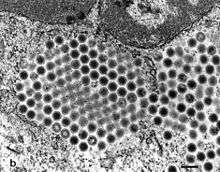Iridovirus
Iridovirus is a genus of viruses, in the family Iridoviridae.[1] Insects serve as natural hosts. There are currently only two species in this genus including the type species Invertebrate iridescent virus 6. Diseases associated with this genus include: in mosquitoes, IIV-6 usually causes covert (inapparent) infection that reduces fitness.[1][2]
| Iridovirus | |
|---|---|
 | |
| TEM micrograph of a cluster of virions | |
| Virus classification | |
| Group: | Group I (dsDNA) |
| Family: | |
| Genus: | Iridovirus |
| Type Species | |
| |
Taxonomy
Group: dsDNA
- Family: Iridoviridae
- Genus: Iridovirus
- Invertebrate iridescent virus 6
- Invertebrate iridescent virus 31
Former species Invertebrate iridescent virus 1 (IIV-1) has been removed from Iridovirus. Its current status is a tentative member of Chloriridovirus.[4]
Structure
Viruses in Iridovirus are enveloped, with icosahedral and Polyhedral geometries, and T=147 symmetry. The diameter is around 185 nm. Genomes are linear, around 213kb in length. The genome codes for 211 proteins.[1][2]
| Genus | Structure | Symmetry | Genomic arrangement | Genomic segmentation |
|---|---|---|---|---|
| Iridovirus | Polyhedral | T=147 | Linear | Monopartite |
Life cycle
Viral replication is nucleo-cytoplasmic. Entry into the host cell is achieved by attachment of the viral proteins to host receptors, which mediates endocytosis. Replication follows the DNA strand displacement model. DNA-templated transcription is the method of transcription. Insects serve as the natural host.[2]
| Genus | Host details | Tissue tropism | Entry details | Release details | Replication site | Assembly site | Transmission |
|---|---|---|---|---|---|---|---|
| Iridovirus | Insects | None | Cell receptor endocytosis | Lysis; budding | Nucleus | Cytoplasm | Contact |
References
- "Iridoviridae". ICTV Online (10th) Report.
- "Viral Zone". ExPASy. Retrieved 15 June 2015.
- ICTV: Master Species List 2018b.v2, on: ICTVonline: MSL #34 as of February 2019
- ICTV: ICTV Taxonomy history: Invertebrate iridescent virus 1 (ZIP)
External links
| Wikimedia Commons has media related to Iridovirus. |
| Wikispecies has information related to Iridovirus |